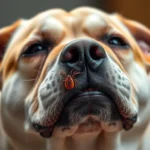
Introduction
Cherry eye in dogs refers to a condition where the nictitating membrane, or third eyelid, prolapses or protrudes from its normal position. This can be concerning for dog owners, as it not only affects the appearance of the eye but can also lead to complications if left untreated. Understanding the anatomy of the dog’s third eyelid is crucial in recognizing and addressing this condition promptly.
The third eyelid plays a vital role in protecting the eye and keeping it moist. For dog owners, having a basic understanding of cherry eye and its implications can lead to better health outcomes for their pets. This article will cover what cherry eye is, its causes, symptoms, diagnosis, treatment options, prevention, and how to live with a dog that has cherry eye.
What is Cherry Eye?
Definition
Cherry eye occurs when the third eyelid’s gland becomes displaced. This gland is responsible for producing a significant portion of the tears that keep a dog’s eyes lubricated. When it prolapses, it becomes visible as a red, swollen mass at the inner corner of the eye, resembling a cherry, hence the name.
Anatomy of the Third Eyelid
The third eyelid, or nictitating membrane, is a thin layer of tissue located in the inner corner of a dog’s eye. It serves several purposes: protecting the eye from debris, aiding in moisture retention, and assisting in tear production. The gland associated with the third eyelid is crucial in maintaining a healthy tear film, which is essential for proper eye function.
Common Breeds Affected
Certain dog breeds are more prone to developing cherry eye due to genetic factors. These include:
- Bulldogs
- Beagles
- Cocker Spaniels
- Boston Terriers
- Shih Tzus
- Pugs
If you own one of these breeds, being vigilant about eye health is especially important.
Causes of Cherry Eye
Genetic Factors
Many cases of cherry eye are attributed to genetic predisposition. Breeds that are known to have this condition often inherit anatomical traits that contribute to the laxity of the connective tissues surrounding the third eyelid. As a result, the gland can easily become displaced.
Environmental Factors
Environmental factors such as allergies and irritants can also play a role in the development of cherry eye. Dogs exposed to pollen, dust, or smoke may experience inflammation and discomfort, leading to an increased risk of the gland prolapsing.
Physical Factors
Physical factors, including the anatomical structure of the dog’s eye and the overall health of the tissues, can contribute to cherry eye. If the connective tissues that hold the gland in place are weak or lax, the likelihood of prolapse increases.
Symptoms of Cherry Eye
Visual Symptoms
The most recognizable sign of cherry eye is the appearance of a red, swollen mass in the inner corner of the affected eye. This can be alarming for dog owners and may be accompanied by a noticeable change in the dog’s eyes.
Behavioral Symptoms
Dogs with cherry eye may exhibit discomfort or irritation. Behavioral symptoms can include:
- Pawing at the affected eye
- Squinting or blinking excessively
- Rubbing the face against surfaces
- Increased tear production
These behaviors indicate that the dog may be experiencing pain or discomfort.
Associated Complications
If left untreated, cherry eye can lead to several complications, such as:
- Conjunctivitis (inflammation of the outer membrane of the eyeball)
- Dry eye syndrome
- Corneal ulcers
These conditions can result in severe pain and further vision problems if not addressed promptly.
Diagnosis of Cherry Eye
Veterinary Examination
Diagnosing cherry eye typically involves a thorough veterinary examination. The veterinarian will visually inspect the dog’s eyes, looking for signs of prolapse and any associated conditions. They will also evaluate the overall health of the eye and surrounding tissues.
Diagnostic Tests
In some cases, additional diagnostic tests may be necessary. These can include:
- Eye pressure tests to assess intraocular pressure
- Tear production tests to evaluate tear gland function
These tests help determine if there are any underlying issues contributing to the condition.
Differential Diagnosis
Several other conditions can mimic the appearance of cherry eye, including:
- Eyelid tumors
- Infections
- Other forms of eye prolapse
It’s essential for veterinarians to differentiate between these conditions to provide the most effective treatment plan.
Treatment Options for Cherry Eye
Non-Surgical Treatments
In mild cases, non-surgical treatments may be effective in managing cherry eye. These can include:
- Anti-inflammatory medications to reduce swelling and discomfort
- Lubricating eye drops to keep the eye moist
While these treatments can alleviate symptoms, they often do not resolve the underlying issue.
Surgical Treatments
Surgery is usually required to correct cherry eye effectively. The most common surgical option is gland repositioning, where the gland is carefully moved back into its proper position. This procedure aims to secure the gland and minimize the risk of future prolapse.
Post-Treatment Care
After surgical intervention, proper care is crucial for recovery. Guidelines for post-treatment care may include:
- Administering prescribed medications, such as antibiotics and anti-inflammatories
- Keeping the surgical site clean and monitoring for signs of infection
- Following up with the veterinarian for scheduled check-ups to ensure healing is progressing
Prevention of Cherry Eye
Regular Veterinary Check-ups
One of the best ways to prevent complications related to cherry eye is through regular veterinary check-ups. Routine examinations can help catch issues early and allow for prompt treatment.
Environmental Care
Minimizing allergens and irritants in your dog’s environment can help reduce the risk of developing cherry eye. This can include:
- Regular cleaning to reduce dust and allergens
- Avoiding exposure to smoke or strong fragrances
- Providing a clean, safe space for your dog to play
Breed Awareness
If you own a breed that is predisposed to cherry eye, discussing breed-specific concerns with your veterinarian is essential. They can provide tailored advice on monitoring eye health and potential preventative measures.
Living with Cherry Eye
Monitoring Your Dog’s Eye Health
If your dog has been diagnosed with cherry eye, it’s important to monitor their eye health regularly. Look for signs of irritation, changes in appearance, or any behavioral changes that could indicate discomfort.
When to Seek Veterinary Help
Knowing when to seek veterinary help is crucial. Signs that warrant immediate attention include:
- Increased redness or swelling of the eye
- Discharge or excessive tearing
- Signs of pain, such as squinting or pawing at the eye
Understanding the Long-Term Outlook
The prognosis for dogs with cherry eye is generally good, especially with prompt treatment. Most dogs respond well to surgical intervention and can lead a normal, healthy life post-treatment. However, some may experience recurrence, so ongoing monitoring is essential.
Conclusion
Recognizing and addressing cherry eye in dogs is critical for ensuring the health and well-being of your furry friend. By understanding the condition, its causes, symptoms, and treatment options, dog owners can take proactive steps in maintaining their pet’s eye health. Regular veterinary consultations and awareness of breed-specific concerns can go a long way in preventing and managing this condition.
Keeping an eye on your dog’s health and seeking veterinary advice when necessary can help ensure your dog remains comfortable and happy.









